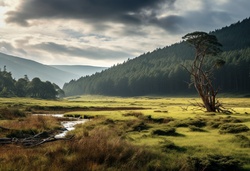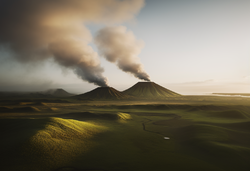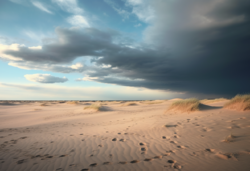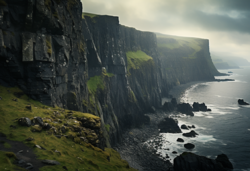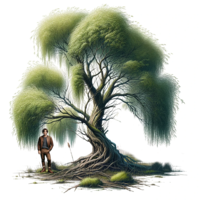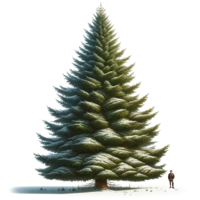Dnkluwos Islands: Difference between revisions
Jump to navigation
Jump to search
(→Flora) |
(→Trees) |
||
| Line 59: | Line 59: | ||
|Predominant in the boreal forest regions, these spruces are characterized by a conical shape and dense, needle-like leaves, suited for snowy conditions. They are known for their strong, durable wood, growing up to 50 meters in height. | |Predominant in the boreal forest regions, these spruces are characterized by a conical shape and dense, needle-like leaves, suited for snowy conditions. They are known for their strong, durable wood, growing up to 50 meters in height. | ||
|[[File:Spruce.png|frameless|200x200px]] | |[[File:Spruce.png|frameless|200x200px]] | ||
|} | |||
=== Plants and Shrubs === | |||
{| class="wikitable" | |||
!Plant Name | |||
!Wolgos Name | |||
!Description | |||
!Image with an Eokoesr for size comparison | |||
|- | |||
|Thermal Bloom (Thermiflora) | |||
|'''Gwherkwetlóh1''' | |||
|Flowers that thrive in warm soils of geothermal areas, with deep roots for warmth access and vibrant colors contrasting the steaming landscape. | |||
| | |||
|- | |||
|Tidal Grasses (Marecauda) | |||
|'''Moritrew''' | |||
|Highly salt-tolerant grasses in northern beach sand flats, able to survive submerged under seawater at high tides and in sunlight at low tides. | |||
| | |||
|- | |||
|Wind Whisper Willows (Aeroflustra) | |||
|'''Wénwhislos''' | |||
|Willows in open plains with long, slender leaves producing a rustling sound in the wind, resembling whispers. | |||
| | |||
|- | |||
|Frost Berries (Glacibacca) | |||
|'''Ghelh3bhér''' | |||
|Berry bushes in highlands, surviving low temperatures and producing sweet berries with a purple and frost like texture. | |||
| | |||
|- | |||
|Alpine Poppies (Altipapaver) | |||
|'''Alpipoh1ós''' | |||
|Brightly burgundy coloured poppies in the rocky soils of the Whwdhoros Highlands, blooming spectacularly during summer. | |||
| | |||
|- | |||
|Ribbon Reeds (Vittaphyta) | |||
|'''Weidhygos''' | |||
|Tall reeds along riverbanks with long, ribbon-like leaves that can grow several meters in length. | |||
| | |||
|- | |||
|Sunset Heath (Solisecalyx) | |||
|'''Sóh2lkweyk''' | |||
|Shrubs with iridescent flowers that change colour throughout the day according to light conditions, from deep red in the twilight of morning or evening to bright yellow at midday. | |||
| | |||
|- | |||
|Valley Cotton (Vallisgossypium) | |||
|'''Gwosom''' | |||
|Herbaceous plant with cotton-like seeds in sheltered valleys, with water-resistant fibres historically used for insulation. | |||
| | |||
|} | |} | ||
Revision as of 07:16, 30 December 2023
| Geo-area | |
|---|---|
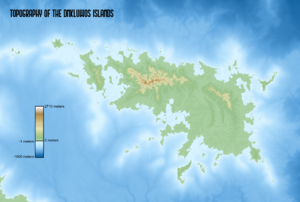 Image description: Natural landscapes of the Dnkluwos Islands | |
| Countries: | Old Dhonowlgos, Rissland |
| Continent: | Anaria |
| Location | |
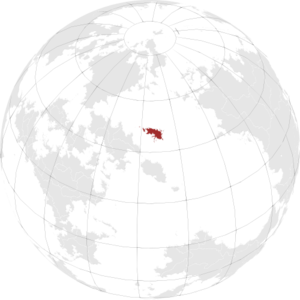
| |

Flora
Trees
Plants and Shrubs
| Plant Name | Wolgos Name | Description | Image with an Eokoesr for size comparison |
|---|---|---|---|
| Thermal Bloom (Thermiflora) | Gwherkwetlóh1 | Flowers that thrive in warm soils of geothermal areas, with deep roots for warmth access and vibrant colors contrasting the steaming landscape. | |
| Tidal Grasses (Marecauda) | Moritrew | Highly salt-tolerant grasses in northern beach sand flats, able to survive submerged under seawater at high tides and in sunlight at low tides. | |
| Wind Whisper Willows (Aeroflustra) | Wénwhislos | Willows in open plains with long, slender leaves producing a rustling sound in the wind, resembling whispers. | |
| Frost Berries (Glacibacca) | Ghelh3bhér | Berry bushes in highlands, surviving low temperatures and producing sweet berries with a purple and frost like texture. | |
| Alpine Poppies (Altipapaver) | Alpipoh1ós | Brightly burgundy coloured poppies in the rocky soils of the Whwdhoros Highlands, blooming spectacularly during summer. | |
| Ribbon Reeds (Vittaphyta) | Weidhygos | Tall reeds along riverbanks with long, ribbon-like leaves that can grow several meters in length. | |
| Sunset Heath (Solisecalyx) | Sóh2lkweyk | Shrubs with iridescent flowers that change colour throughout the day according to light conditions, from deep red in the twilight of morning or evening to bright yellow at midday. | |
| Valley Cotton (Vallisgossypium) | Gwosom | Herbaceous plant with cotton-like seeds in sheltered valleys, with water-resistant fibres historically used for insulation. |
